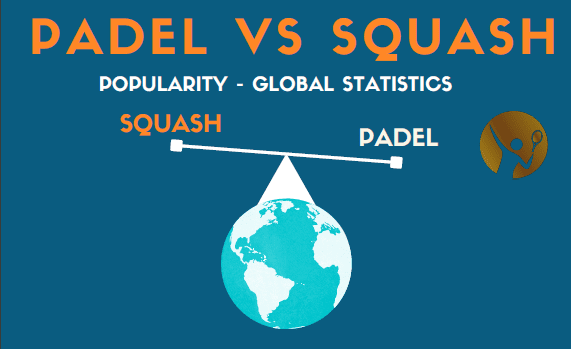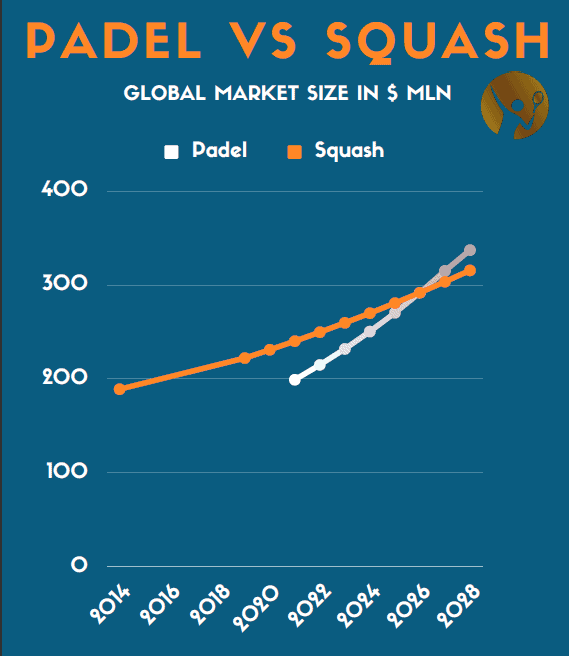This post may contain affiliate links.

Both padel and squash are played around the world by many people, but which sport is more popular? Rather than asking random people, I analyzed the statistics and come to the following conclusion.
Padel is rapidly gaining popularity and grows faster compared to squash in terms of number of players, market size and exposure. However currently the global market size for squash is bigger compared to padel but padel is expected to surpass by 2025.
In this article, I extensively discussed the growth of squash from three different angles: the number of players, market size, and exposure. In order to make a meaningful comparison, I will discuss padel along the same dimensions.
If you are only interested in a particular topic, feel free to jump to that section using one of these buttons:
Padel vs Squash : Number of players
Globally there are around 18 million active padel players, compared to around 20 million squash players. In general, squash and padel are played most often in Europe and Pan America, but several countries in Africa and Asia are growing in terms of squash and padel players.
As mentioned, these players are not equally distributed across the countries, so let’s unpack the underlying trends in each region.
But first.. one important caveat to consider: you need four people to fill a padel court, whereas you only need two players in squash! That is why I argue that the number of courts is also a valuable statistic to include.
Pan America
Although squash is expected to grow in the US it is unlikely that it will keep up with the massive growth of padel in the US, Argentina, and Mexico.
In the United States, there were 1.49 million squash players in 2017, an 80% increase compared to five years earlier. The growth of 400% among junior players is promising for further growth in the US. If we zoom out and look at Pan America (that is, North, Central, and South America combined), there are 2 million active squash players. Even though this does not include occasional squash players, it can be concluded that the US is the main contributor in this region.
The same cannot be said about padel in this region. There were only around 10,000 players and 160 padel courts in 2021. However, the US recognizes the potential of padel and is heavily investing in the sport. The United States Padel Association has set its ambition to reach 8 million padel players in the US and have a total of 30,000 courts by 2030.
has set its ambition to reach 8 million padel players in the US and have a total of 30,000 courts by 2030.
Argentina is the main representative in Pan America when it comes to padel. In Argentina alone are already 2 million padel players and 4900 padel courts. The number of padel courts is growing in Mexico, Chili and Paraguay as well. In 2020, 1,200 new courts were built in Mexico.
were built in Mexico.
Although squash is expected to grow in the US it is unlikely that it will keep up with the massive growth of padel in the US, Argentina, and Mexico.
Europe
While the number of squash players is higher in some European countries, there are more padel players in Europe.
Even though there were 269,000 squash players in 2020 in the UK, it Is losing a portion of its popularity. The number of squash players is expected to grow in Italy and France due to national efforts. In Finland squash is also considered a growing with around 500,000 enthusiasts.
According to Playtomic , in 2021 there were 3.5 million padel players in Spain alone! Although this number is not as big in the rest of Europe, there were still 500,000 players in Italy and 540,000 in Sweden in the same year. To make it comparable, in the UK and Finland were 10,000 padel players and 55,000 players respectively.
, in 2021 there were 3.5 million padel players in Spain alone! Although this number is not as big in the rest of Europe, there were still 500,000 players in Italy and 540,000 in Sweden in the same year. To make it comparable, in the UK and Finland were 10,000 padel players and 55,000 players respectively.
While the number of squash players is higher in some European countries, there are more padel players in Europe.
Oceania
In Oceania, the number of squash players is declining, including in Australia where squash used to be more popular. While padel is becoming more popular globally, it is not a big sport yet in Oceania, since there are only 22 padel courts in Australia.
Africa and Asia
Although squash is not well-known in Asia and Africa, there are some exceptions. Egypt, Pakistan, and Malaysia are countries where squash has big growth potential since they have delivered many professional squash players. Padel is not a big sport in Asia and Africa, except for the Middle East. Many investors noticed the growth potential of padel and new padel courts were built to host global tournaments like WPT and Premier One. Besides Qatar, United Arab Emirates, also Egypt is investing in the construction of padel courts (350 courts in 2022) and venues in order to host tournaments.
In general, squash and padel are played most often in Europe and Pan America, but several countries in Africa and Asia are growing in terms of squash and padel players.
Padel vs Squash : Market size

The global padel market is valued at $198.5 million in 2021 and is expected to grow to $337.2 million by 2028. The squash racket market increased between 2014 and 2019 by 17.7% from $188.4 million to $221.7 million. Currently, the global padel market (8%) is growing twice as fast as the global squash market (4%). Padel is expected to surpass squash in terms of global market size by 2025.
If we zoom in a bit deeper and turn our focus toward the different continents, the European padel market contains nearly half of the global market. This seems logical if you know about the increase in popularity of padel in Europe. Latin America is second, mainly due to the contribution of Argentina. Sales have doubled in the Argentina padel market after the pandemic (2019-2021). Third on the list is North America, where padel is mainly gaining traction in the US.
More than 60% of the global market is owned by the five biggest racket sports manufacturers. These companies invest heavily in the growth of padel by expanding their product lines, such as rackets, balls, bags, shoes, clothing, and accessories. You might wonder what type of product line the manufacturers focus on. Let me give you a fun fact: Padel rackets contribute to over 90% of all padel products sold!
Europe was leading the squash racket market, capturing $58.6 million in 2019. However, around 2030 North America is expected to surpass and take over this leading position. While Europe captures 26.4% of the market and North America growing at a rapid rate, there are others to consider. For example, South East Asia captured around 4% of the total squash racket market in 2019 and is expected to grow moving towards 2030.
Despite the fact we noticed a decline in the number of squash players, the squash racket market is expected to grow in Australia and New Zealand. They are considered the largest and fastest-growing markets in that region, capturing over $15 million in 2020.
Padel vs Squash : Exposure
As a result of the traction gained on each platform in combination with growing interest in the sport, padel is gaining more exposure overall than squash.
Just like in any sport, any internationally renowned player is a boost to exposure and therefore the national interest in squash or padel. Think about the popularity that squash player Paul Coll has in Australia and female squash player Nour El Sherbini in Egypt. The same holds for padel players, like Fernando Belasteguín in Argentina and Alejandro Galán in Spain.
Besides famous squash players, there are numerous others that contribute to the growth. Celebrities are also playing an important role in the growth of both padel and squash. Football players like Zinedine Zidane and Zlatan Ibrahimovic have opened their own padel clubs. Tennis player Andy Murray is involved in a company that is investing in a network of padel centers in the UK. As a result, these sports figures promote the growth of padel by encouraging their fans and followers to play the game as well. This is also the case for squash where tennis player Roger Federer actively promotes squash initiatives. Next to that the Dutch football legend Marco van Basten is promoting squash in the Netherlands.
Another important vehicle for expansion is sponsors and partnerships. While it seems obvious for racket brands in the padel or squash market to partner with the tournament organizers, there are other companies (outside the industry) that invest in the sport as well. In this article, I discussed the role of sponsors and partnerships in the growth of padel.
Nowadays it is easier to get exposure than ever before because initiatives can reach a global audience and online broadcasting is more popular. Both Squash and Padel use platforms like YouTube but also have their own platforms. SquashTV was developed in 2019 by PSA, the governing body of squash. In 2021 World Padel Tour made a similar move and created its own broadcasting platform World Padel Tour TV. Both padel and squash are broadcasted on several national TV stations, but padel is broadcasted in more countries compared to squash. As a result of the traction gained on each platform in combination with growing interest in the sport, padel is gaining more exposure overall than squash.






